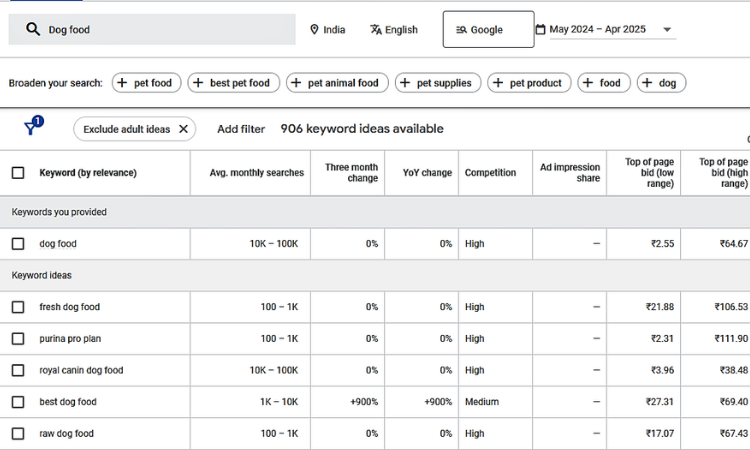Google processes around 8.5 billion searches every day, that’s nearly 99,000 every second. People go online daily looking for answers, services, or products. With strong SEO content, you can position your site to appear on search engine result pages (SERPs).
In this blog, you’ll discover proven SEO content writing tips and tools, and a clear structure to follow. We’ll cover everything from basics to advanced, including keyword research and competitor analysis, on-page SEO, and avoiding common mistakes. This guide will help you understand how to write SEO-friendly content that ranks well and genuinely helps readers.
Let’s dive into the world of SEO writing!
What Is SEO Content?
Simply put, SEO content is any content created to rank on platforms like Google, Bing, or even AI-driven search tools like ChatGPT, Gemini, Perplexity and Grok. The content could be a blog post, product page, landing page, guide, or any web page optimized for search. In simple terms, SEO content is written to attract search engine traffic.

For example, a restaurant’s location page optimized for “best South Indian food in Ahmedabad” or a blog post titled “Top 5 Dosa Spots in Gujarat” are both examples of SEO content. They help the restaurant show up when someone searches for local dining options.
The three key goals of SEO content are to rank higher, attract relevant traffic, and address user intent effectively. What sets SEO content apart from regular content is its strategic alignment with how people search online.
It’s not just about adding keywords – it’s about creating well-structured, topic-relevant content that answers specific queries, includes internal and external links, uses schema markup where needed, and follows a logical hierarchy with optimized titles, meta descriptions, and headings.
This ensures your content performs well both technically (for search engines) and contextually (for real people). Striking this balance is crucial for SEO success today.
Why Is SEO Content Important for Rankings?
High-quality SEO content is a secret ingredient for the success of search rankings. Search engines are trained to show users the most helpful and relevant results. Google explicitly states that its ranking systems “present helpful, reliable information that’s primarily created to benefit people, not to gain search engine rankings”. In other words, content that genuinely helps users (and satisfies their search intent) is rewarded with better visibility.
Good SEO content also attracts backlinks and engagement, which boost a site’s authority. For example, pages on authoritative domains tend to outrank lesser-known sites. If you have valuable and informative content on your website and it genuinely helps users solve their queries, your content is more likely to be linked by others, signalling to search engines that your site is trustworthy. Google’s guidelines advise focusing on “people-first” content – content created for users, not just to manipulate rankings.
How to Write SEO Content That Ranks: Step-by-Step Guide
Follow this guide to structure and optimize your content to rank from start to finish:
- Start with Keyword Research
- Analyse Competitor Content
- Plan a Clear Content Structure
- Write a Strong and Engaging Introduction
- Optimize Content for On-Page SEO
- Write for Humans First, Search Engines Second
- Use Visuals to Enhance Content
- Use a Clear Call-to-Action (CTA)
- Add a Compelling Meta Title and Description
- Update Content Regularly
Let’s explore each step in detail:
1. Start with Keyword Research
High-quality SEO writing begins with keyword research. Use long-tail, low-competition keywords from your topic. For instance, instead of just “dog food,” you might target “best organic dog food for small breeds.” These niche phrases have lower search volume but higher relevance and conversion potential.
You can use a free tool like Google Keyword Planner, or paid tools like Ahrefs, SEMrush, and Ubersuggest to find the best keywords for your topic.


2. Analyse Competitor Content
It’s better to know what your competition is writing and publishing. Before writing, analyse top-ranking competitors’ content on your chosen topic.
- Conduct a basic Google search and look at the articles or pages already ranking on page one.
- What keywords are they using?
- How is their internal content structured?
- What questions do they answer?
- How do they use visuals or videos?
This competitive research reveals what readers (and Google) expect.
As SurferSEO advises, competitor analysis “helps you pinpoint the exact type of content search engines and readers deem helpful and relevant at a given time.” SurferSEO is one such tool for SEO content writing that helps you analyze your competitors’ content, keywords, headings, etc. Note down things like headings, length of content, common themes, and the balance of text and media. Identify content gaps or topics your competitors haven’t covered well.
3. Plan a Clear Content Structure
Google’s algorithm is designed to analyze content and show as on the users’ queries. A clear, scannable structure, including headings (H1, H2, H3, etc.) to break your content into logical sections, is essential. Yoast SEO explains that without headings, readers face an “infamous wall of text” that is hard to navigate. Well-crafted headings make content easier to skim and understand. They should summarize each section’s main point and include relevant keywords naturally when possible.
- Good structure also improves accessibility and SEO. Screen readers can jump between headings, and search engines use headings to interpret page topics.
- Always start paragraphs with a topic sentence, and use subheadings to group related points.
- Add bullet points or numbered lists to highlight key ideas.
Overall, a clear outline helps keep you on topic and keeps readers engaged.
4. Write a Strong and Engaging Introduction
Your introduction must hook the reader and clearly state what the content will cover. Use the target keyword early (in the first 100 words) if it fits naturally. Avoid fluff or irrelevant tangents. Neil Patel emphasizes that the intro’s job is to convince readers to continue. “If your introduction is weak, it’ll discourage the reader from reading further – even if the title was captivating,” he warns.
- A good introduction starts with a question, a story, a fact, or a bold statement that relates to the topic.
- Keep it concise and interesting.
- Ending the introduction with a transition into the main content builds momentum.
Remember, even the best content fails if a user hits the back button before getting started. So write an intro that grabs attention and shows readers why they should stay.
5. Optimise Content for On-Page SEO
On-page SEO ensures search engines easily understand your content. Here are the key on-page practices:
- Headings (H1, H2, H3): Use headings to organize content. The H1 is usually your title, and H2s/H3s divide sections. Include keywords in some subheads naturally..
- URL: Make the slug short, descriptive, and keyword-rich if possible (e.g. …/seo-content-writing-tips).
- Keyword Placement: Sprinkle your focus keyword and related terms throughout the content, especially in the first paragraph and in headers. But avoid overuse.
- Internal Links: Link to other relevant pages or blog posts on your site. This helps search engines crawl your site and keeps readers exploring your content.
- External Links: When relevant, cite or link to reputable sources. This adds credibility.
- Images and Alt Text: Use descriptive filenames and alt text for images, including keywords when appropriate. Google’s image SEO guide reminds that high-quality images boost user engagement when optimized for fast loading.
- Mobile-Friendliness & Speed: Ensure your content loads quickly and displays well on mobile devices. Page experience affects rankings. Google advises optimizing images and using responsive design for a fast experience
6. Write for Humans First, Search Engines Second
Remember, there will always be a human on the other side to consume your content. So, write for humans and not for search engines to rank.
Ensure the content you produce follows the Experience, Expertise, Authoritativeness, and Trustworthiness (E-E-A-T) formula. It helps you create valuable content that will genuinely help the users. If your content helps users with their queries, it sends a strong signal to search engines to rank your content.
- Avoid writing that only appeals to algorithms. Use a natural tone, answer questions fully, and provide useful examples or insights.
- Avoid keyword stuffing at all costs. This outdated practice of overloading keywords is likely to HARM, not help your SEO.
- Write conversationally if it fits your style. Break up complex ideas into simple terms. Use short paragraphs for readability.
7. Use Visuals to Enhance Content
Visual elements (images, infographics, charts, videos) make content more engaging and memorable. Articles with good visuals get much higher views and shares. Include relevant images or diagrams to convey key points or data. Make sure every image has a descriptive alt text so search engines understand the image context. Optimize image file sizes to keep page load times fast.
8. Use a Clear Call-to-Action (CTA)
Always end your content with a CTA. It tells users what to do next. Example: “Buy Now,” “Download free guide.” A CTA helps convert readers into subscribers, customers, or engaged followers.
9. Add a Compelling Meta Title and Description
The title tag should be catchy. Include your main keyword, and fit within ~50–60 characters so it doesn’t get cut off. The meta description (150–160 chars) is your chance to persuade searchers to click your result.
Example:
- Title: How to Write SEO Content That Ranks | [YourBrand]
- Meta Description: Learn practical SEO content writing tips and tools. This guide shows you how to research keywords, structure content, and optimize posts to rank higher.
10. Update Content Regularly
Search engines prefer to present fresh, updated, and valuable content. Periodically review your SEO articles and update them with the latest information, statistics, or insights. Fix any broken links and improve sections that underperform. When you update content, you also get another chance to re-promote the page and earn new backlinks.
Also Read: Best Off-Page SEO Techniques to Use in 2025
Best Tools to Help You Write SEO Content
Writing great SEO content becomes easier with the right tools. Here are some top tools for each step:
- Google Keyword Planner: A free tool to find keyword ideas and search volumes.
- Ahrefs / SEMrush: Comprehensive SEO suites. Use them for deep keyword research, analyzing keyword difficulty, tracking rankings, and checking competitors’ backlinks.
- Surfer SEO / Frase: Tools that analyse top-ranking pages and provide content guidelines. They suggest optimal word counts, keyword usage, and related terms to tailor your content to match the topic’s demand.
- Grammarly / Hemingway Editor: Writing assistants to improve grammar, clarity, and readability.
- Yoast SEO (WordPress users): It gives real-time feedback on keyword usage, readability, meta tags, and more. Yoast checks your headings, sentence length, and SEO score as you write.
- ChatGPT, Grok, Gemini (AI Writing Tools): These AI models – ChatGPT (GPT‑4‑turbo), Grok (by xAI, integrated with X), and Gemini 1.5 (by Google) – can help you brainstorm, outline, and refine content faster. They’re trained on vast datasets and support natural language prompts, but always apply your expertise for accuracy and tone.
SEO Content Writing Mistakes to Avoid
Even experienced writers fall into SEO traps. Avoid these common mistakes:
- Keyword Stuffing: Repeating the keyword unnaturally throughout the content affects your chances of ranking.
- Writing for Bots, Not People: Write for humans and to provide value. Google’s advice is to create “people-first content”.
- Ignoring Search Intent: Crafting content that doesn’t match what users actually want is a red flag. Always ask: Is this post answering the question or need behind the search?
- Skipping Proper Structure: Neglecting headings, lists, and short paragraphs. This makes your article hard to read. Use H2s/H3s, bullets, and images to break up text.
- Not Tracking Performance: Hitting the publish button and never coming back to check its performance is a minus point. Use Google Analytics, Search Console, or SEO tools to monitor traffic, rankings, and engagement.

Final Thoughts
Writing SEO content that ranks isn’t just about inserting the right keywords; it’s about creating genuinely useful, structured, and engaging content that addresses what your audience is searching for. From thorough keyword research to strong on-page optimization and user-focused writing, every step plays a role in improving visibility and engagement.
At AP Web World, we bring over 13 years of experience in helping businesses create high-performing content that delivers real results. If you’re looking to work with the best digital marketing agency in India, our team is ready to help you build an SEO strategy that stands out in today’s competitive digital space.
Ready to grow your traffic and leads through expert SEO content?
Let’s get started — Contact us to discuss your goals.






